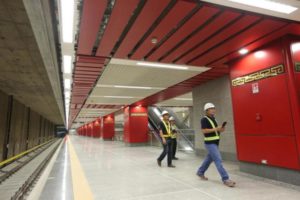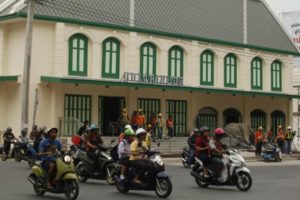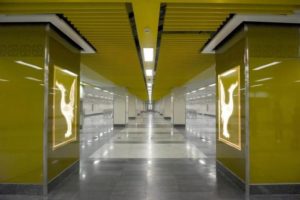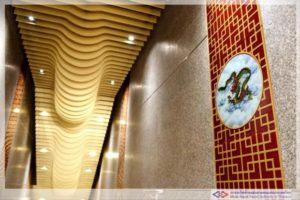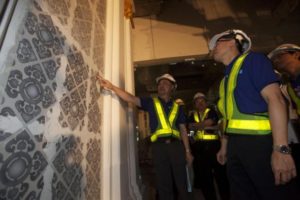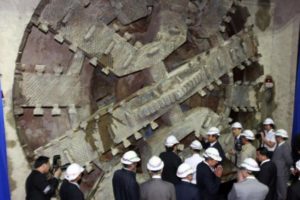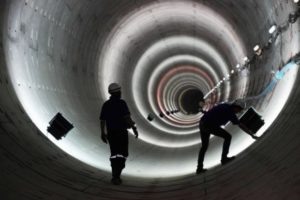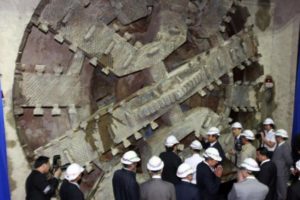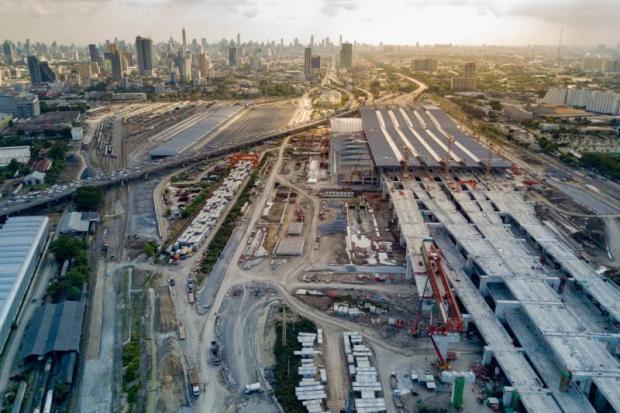
Thai-style artwork to adorn the MRT’s ‘heritage’ line
Commuters, visitors to soak in history as they pass through four new stations on the MRT Blue Line
26 August 2018
Subway stations can be more than just spaces where commuters try to hectically get on or off the train.
Across the world, there are well-designed and elaborately ornate metro stations like in Moscow, where stepping onto the subway station can be described as a visit to a small museum or art space.
Soon, Bangkok commuters can also get a taste of such an experience when the MRT Blue Line’s Extension begins service in September of next year. Four of the new 11 stations in the extension will be covered in artwork on the line which will stretch from the existing MRT’s Hua Lamphong station to Lak Song (at Phutthamonthon Sai 4).
These four stations are Wat Mangkon, Sam Yot (locally known as Wang Burapha), Sanam Chai and Itsaraphap.
In contrast to the greyish, blocky stations of the present MRT, these four stations will be donned with unique, intricate designs to reflect the areas above them. This stretch of stations will run directly below Bangkok’s Old Town, also known as Rattanakosin Island.
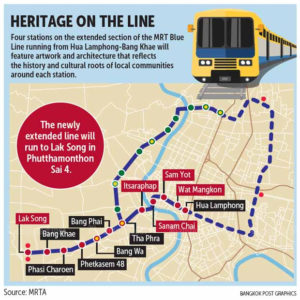 Because construction of these stations is taking part in the old town, where the Grand Palace, and other national landmarks are located, the Rattanakosin Island Committee has ordered the Mass Rapid Transit Authority of Thailand (MRTA) to design the stations to highlight national heritage and cultural roots, according to Vithaya Punmongkol, project director of the MRT Blue Line Extension.
Because construction of these stations is taking part in the old town, where the Grand Palace, and other national landmarks are located, the Rattanakosin Island Committee has ordered the Mass Rapid Transit Authority of Thailand (MRTA) to design the stations to highlight national heritage and cultural roots, according to Vithaya Punmongkol, project director of the MRT Blue Line Extension.
The committee, chaired by Deputy Prime Minister Gen Prawit Wongsuwon, is required by law to monitor any construction within a 5-kilometre area around Rattanakosin Island to preserve its historic significance. The committee also includes members of the Crown Property Bureau and the Fine Arts Department, among others.
“We held talks with the committee from the start and specified in the construction contracts of the stations that the contractors will be held responsible for hiring firms to design them,” Mr Vithaya told the Bangkok Post.
“The overall design and approval process between contractors and the committee alone must have taken around a year to conclude,” he added.
The construction and interior decoration of the four stations already complete. Yet, it will take another year for them to be officially opened for public use, Mr Vithaya said.
Of the four stations, Sanam Chai, located just five minutes away (by foot) from the Grand Palace, seems to be the talk of the town. The station is also in close vicinity to the Museum of Siam, in Tha Tian area and Pak Khlong Talat, the flower market area.
The MRTA opened the station for media and public viewing of the interior design earlier this year. Since then, photos of the splendid design of Sanam Chai station has gone viral and drawn praise.
One of the many reasons that this particular station is so popular is the credibility of the designer. The Rattanakosin Island Committee specifically chose Pinyo Suwankiri, a 1994 National Artist in Visual Art to design the station’s interior.
A professor of Thai architecture at Chulalongkorn University, Mr Pinyo — mostly known as Ajarn Pinyo — has designed hundreds of temples, shrines, pavilions and public offices such as the Supreme Court with traditional Thai architecture. He even designed the Thai Pavilion in Chicago, which was built to mark the 80th birthday of the late monarch.
While Sanam Chai’s design has been touted as reminiscent of early-Rattanakosin-era architecture, with its temple-like pillars, luxurious dark red colouring, high ceilings and chandeliers, Mr Pinyo, now 81, in fact, told the Bangkok Post his design was “actually nothing of the sort”.
“The station’s appearance wasn’t a direct reference to anything. It is my own design and you won’t be able to find this anywhere else,” he said.
His design at the Sanam Chai station has been hailed by traditional art critics as the epitome of “Thainess” and emblematic of Ratanakosin Art, a period of Thai traditional art which started with the birth of the current Chakri Dynasty, over 200 years ago.
The national artist begged to differ and said he was not trying to make any statement.
“The concept of ‘Thainess’ is completely in the eye of the beholder. You could wear a traditional loincloth and call it “Thai”, or you could look at this station’s design and think the same,” he added.
After completing the design, Mr Pinyo admitted he was surprised at the positive feedback received from the public even before the station has opened for service.
Even consulting firms and contractors, CH Karnchang Plc and US-based consulting firm Aecom, showed their enthusiasm in this project from the start. Instead of discussing the design at the office, senior representatives of these firms visited the national artist’s residence to discuss the design early in the construction period.
“This was the first station I have designed but we had to observe a high standard,” said Mr Pinyo, adding that he had to order special colour to be made in order to paint the station’s interior.
Staying true to Thai tradition, Mr Pinyo made sure to only use a deep dark red palette known as dang makham, or red tamarind to paint the station’s interior.
The red tamarind palette, he said, provides a stunning contrast as it darker compared to the more familiar vibrant red seen in Chinese designs.
Sanam Chai is one of the two stations under contract with contractor CH Karnchang Plc and US-based consulting firm Aecom which Mr Pinyo designed. The other two stations, Itsaraphpa, across the Chao Phraya River in Thon Buri, and Wat Mangkon located near Wat Mangkon Kamalawat or “Dragon Lotus Temple”, in Bangkok’s Chinatown were not designed by Mr Pinyo.
The designer of Wat Mangkon station, located only 200m away from the temple, gave the station a traditional Chinese look.
While the interiors of Sanam Chai is painted in deep dark red, the Wat Mangkon is coated in bright red colours, which is an auspicious colour in Chinese culture signifying abundance.
Strips of bright red along the walls and ceilings contrast with the marble tiles inside the station, which is laced with traditional Chinese fretwork, again alluding to abundance and longevity. The station also houses a coiled dragon suspended on its ceiling, and features a large, long dragon’s belly, stretching over the station’s escalators.
The contractor of this station, Italian-Thai Development Plc, enlisted the highly regarded UK-based firm, Arup Group Ltd to design Wat Mangkon. Arup Group has previously designed other high profile projects in Thailand, such as the MahaNakhon Tower, which is the highest building between Silom and Sathon roads.
Another project undertaken by both Italian-Thai Development Plc and Arup Group is Sam Yot Station located in the Wang Burapha area.
“Sam Yot”, which means three spines, pays homage to the historic outer doors of the Rattanakosin capital, where the station is also located. These doors date back to the Rama I era, over 200 years ago. However, this particular entrance was reshaped — hence three spines — during Rama V’s rule, as the previous single door was too narrow and led to many horse-cart accidents.
“The pillars inside the stations are decorated with images of life in the Rattanakosin era, with a special focus on the commercial activity at that time, Mr Vithaya said. “These include historic pictures of the famed Seng Chong store, which makes leather products for the Royal Family,” he said
The last station, Itsaraphap, is the first subway station located in the Thon Buri area. The route to the station from Sanam Chai features an underground tunnel which runs directly under the Chao Phraya River.
Despite the station’s location being outside the old town, Mr Vithaya said that the Rattanakosin Island Committee specified that this station should also be designed with historic significance in mind. Thus, Itsaraphap’s design was inspired from arguably the most well-known temple in the area, Wat Hong Rattanaram.
In the Thai language, “Hong” means swan, so the decoration of the station reflects the eponymous name.
Subsequently, Itsaraphap’s design features a regal, golden colour scheme. Several of the pillars are also decorated with the iconic Thai swan.
During the construction of the four stations, the MRTA reportedly found historic artefacts while digging the underground routes.
“Construction practically served as an excavation mission as we found traditional daggers, coins and old building pillars at Sanam Chai, and some old railway tracks at Sam Yot,” Mr Vithaya said. He said that the artefacts will be displayed at Sanam Chai.
The marvellous designs of these four stations have led the Rattanakosin Island Committee to ask the MRTA to design other stations in old town areas to highlight historical roots too. Last March, the committee approved designs for three new stations along the western Orange Line, now tipped to be located near Sanam Luang, Democracy Monument and Siriraj Hospital.
Although bidding for this Orange line which starts from Thailand Cultural Centre to Taling Chan area in Thon Buri has yet to commence, the public can likely expect to see at least three more stations specifically designed to reflect the capital’s famed Old Town.
Source: https://www.bangkokpost.com/news/special-reports/1528614/thai-style-artwork-to-adorn-the-mrts-heritage-line
